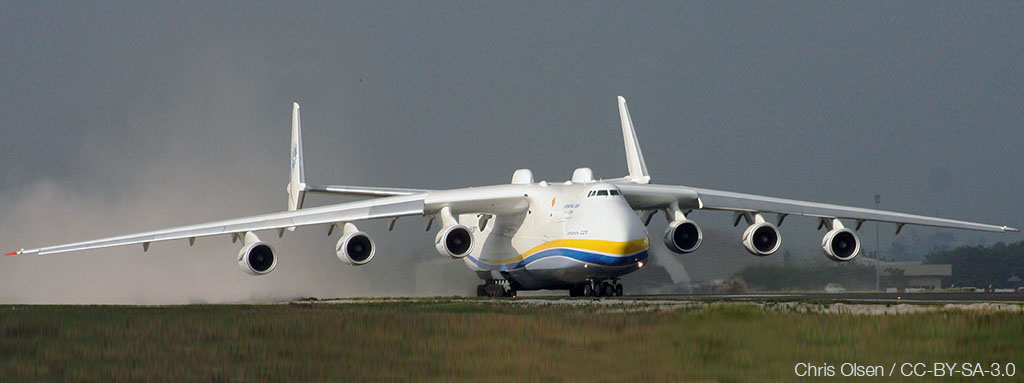The aviation industry has been characterised by facing challenges and setting itself ambitious goals. In its origins, the focus was placed on flying as far as possible. Once the entire world became accessible, however, efforts shifted to other technical achievements like flying faster, higher or carrying heavier payloads. As the Olympic motto states, “Citius, altius, fortius”. This article will discuss the world’s most powerful and largest aeroplane, the impressive Antonov An-225. Its nickname Mriya means “dream” in Ukrainian, a clear reflection of its amazing nature.
The An-225 is a machine that has set many records. In fact, more than 200 are recorded in the Guinness Book of Records.
This aeroplane’s uniqueness does not only reside in its specifications, but also due to the fact that only one complete unit has ever been manufactured. This is due to the project’s peculiar origins, the Soviet space programme and the era of space shuttles. NASA used shuttles from 1981 to 2011. To transport them, they were placed on top of a modified Boeing 747 Jumbo fuselage, the largest passenger aircraft at the time. The Russians also designed a space shuttle, which was known as Buran, and only one unit was built in 1988. They also needed an extremely large aeroplane and, thus, the An-225 was born. Unfortunately, the Russian shuttle only managed to complete a single suborbital flight, after which the programme was cancelled and so was its transport aeroplane. This happened abruptly, coinciding with the collapse of the Soviet Union in 1991 and leaving a second aeroplane half finished.
The An-225 which had been completed was stored without engines, waiting for better times, which surprisingly came about ten years later. As we mentioned above, the USSR no longer existed and the company Antonov Airlines was now a Ukrainian airline. As the ever-increasing need for air transport gathered pace, the An-124s in its fleet (the design which was the Mriya’s precursor) were becoming too small for some orders. The existing unit was therefore equipped with new engines, its registration number was changed for one of its new country, UR-82060, and it was certified by the Interstate Aviation Committee on 23 May 2001 so it could operate once again. The first commercial flight took off from Stuttgart and headed to Thumrait in Oman on 3 January 2002 carrying 187.5 tonnes of ready‑prepared meals.
The An-225 became the leviathan of the skies once more, a beast of burden capable of carrying enormous payloads to places that could not be reached by any other kind of vehicle. It is a machine that has set many records. In fact, more than 200 are recorded in the Guinness Book of Records. One well worth noting took place on 11 August 2009, when it transported the heaviest and densest payload in history on a single flight from Frankfort‑Hahn to Yerevan-Zvartnots (around 3,000 km). Its cargo was a generator built by Alstom for an Armenian power plant measuring 16.23 m long and 4.27 m wide which weighed 189,980 kg. This is currently the world record for air transport cargo. It also set another record on 11 June 2010, when it carried the longest payload ever in history. It consisted of two experimental wind turbine blades measuring 42 metres long from a factory in Tianjin in China to Denmark.
To conclude, here are some technical details to illustrate its power. The AN‑225 is the world’s largest aeroplane. It is 84 metres long, 18 metres high and has a wingspan of 88 metres. It also has the heaviest maximum take-off weight at 640 tonnes. Six turbofan engines having a thrust force of 230 kN each are needed to move it. It creates so much turbulence in its wake it that the next aeroplane to take off behind it has to wait 15 minutes for the turbulence to die down. It should be mentioned as a constraint that it cannot take off from just any airport, since it needs up to 3.5 km of runway to do so. Its landing gear is fitted with 32 wheels to bear its weight, yet another record set by this remarkable aircraft.



